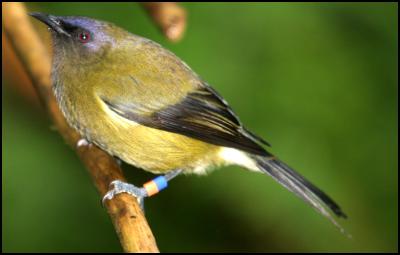Urban Ark Asks For Public Help For Bird Monitoring
Wellington’s ‘urban ark’ Karori Wildlife Sanctuary is getting the public on board to help with a new bird monitoring programme

Click to enlarge
Photo by Tom Lynch, Karori Wildlife Sanctuary (Banded bellbird)
Wellington’s ‘urban ark’ Karori Wildlife Sanctuary is getting the public on board to help with a new bird monitoring programme.
Have you seen a bellbird by the Beehive or a kaka in Khandallah?
The Sanctuary, which was the first of its kind in the world, has succeeded in bringing back at least ten bird species that had disappeared from the city. As these populations grow within the safety of the Sanctuary’s famous predator-proof fence, some birds are beginning to be seen outside the fence, and birds such as kaka are an increasingly common sight in local parks and gardens.
“We are talking about some of the most threatened bird species in New Zealand here. It’s incredible to think that people in Wellington are having kaka, hihi and saddleback visit their gardens.” Says Conservation Scientist, Raewyn Empson.
“If you are lucky enough to see them outside of the Sanctuary, we’d really like to know, because it gives us a better idea of where they are going and how they are coping with city life. This is the first time many of these species have been reintroduced to a mainland site, let alone to a city environment, so this really is groundbreaking conservation work, and we need your help.”
Most of the birds released and then bred at the Sanctuary are given a unique set of ‘bands’ – coloured bracelets placed on each leg. These help us to identify individual birds so we can monitor their survival, breeding success and movements. If you see a banded bird, or a bird you know or think is uncommon, make a note of where and when you saw it, what it was doing and, if possible, record the band colours on each leg. Usually there are two bands on each leg, so read them from top to bottom for each leg. Then log on to the Sanctuary website www.sanctuary.org.nz, and click Report a Bird. You can also print this form out so you have it readily to hand and there is additional information on the website about how to identify and record the coloured bands. If you have your camera close to hand, you can even send us a photo!
ENDS


 Hugh Grant: How To Reduce Network Bottlenecks
Hugh Grant: How To Reduce Network Bottlenecks Dominion Road Business Association: Auckland Transport's 'Bus To The Mall' Campaign: A Misuse Of Public Funds And A Blow To Local Businesses
Dominion Road Business Association: Auckland Transport's 'Bus To The Mall' Campaign: A Misuse Of Public Funds And A Blow To Local Businesses Parrot Analytics: A Very Parrot Analytics Christmas, 2024 Edition
Parrot Analytics: A Very Parrot Analytics Christmas, 2024 Edition Financial Markets Authority: Individual Pleads Guilty To Insider Trading Charges
Financial Markets Authority: Individual Pleads Guilty To Insider Trading Charges Great Journeys New Zealand: Travel Down Memory Lane With The Return Of The Southerner
Great Journeys New Zealand: Travel Down Memory Lane With The Return Of The Southerner WorkSafe NZ: Overhead Power Lines Spark Safety Call
WorkSafe NZ: Overhead Power Lines Spark Safety Call



